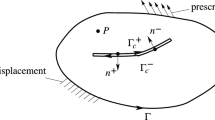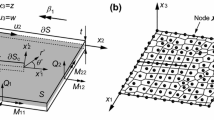Abstract
This paper presents a new intrinsic enriched element free Galerkin method (EFGM) criterion for the simulation of multiple interacting crack problems. The principle attraction of the proposed criterion lies in its ability to handle multiple cracks of equal/unequal lengths. According to this proposed criterion, few modifications are made in standard intrinsic enriched EFGM criterion to solve multiple interacting cracks lying on the same as well as on the opposite face under plane stress conditions. The values of mode-I and mode-II stress intensity factors have been evaluated using domain based interaction integral approach. The modeling capabilities and accuracy of the proposed criterion has been demonstrated by comparing the results with those obtained by FEM. The proposed enrichment criterion has been found quite capable in analyzing crack growth as well as equal or unequal size multiple cracks.
Similar content being viewed by others
References
Beer P, Johnston E, DeWolf T (2002) Mechanics of materials. Mc Graw-Hill International Edition, London
Belytschko T, Lu Y (1994) Element-free Galerkin methods. Int J Numer Methods Eng 37: 229–256
Belytschko T, Fleming M (1999) Smoothing, enrichment and contact in the element-free Galerkin method. Comput Struct 71: 173–195
Belytschko T, Loehnert S (2007) Crack shielding and amplification due to multiple micro-cracks interacting with a macrocrack. Int J Fract 145: 1–8
Belytschko T, Lu YY, Gu L (1995) Crack propagation by element-free Galerkin methods. Eng Fract Mech 51: 295–315
Benzley SE (1974) Representation of singularities with isoparametric finite elements. Int J Numer Methods Eng 8: 537–545
Broek D (1991) Elementary engineering fracture mechanics. Kluwer, Berlin
Budyn E, Zi G, Moes N, Belytschko T (2004) A method for multiple crack growth in brittle materials without re-meshing. Int J Numer Methods Eng 61: 1741–1770
Chen YZ (1984) General case of multiple crack problems in an infinite body. Eng Fract Mech 20: 591–597
Dag S (2006) Thermal fracture analysis of orthotropic functionally graded materials using an equivalent domain integral approach. Eng Fract Mech 73: 2802–2828
De S, Bathe KJ (2001) The method of finite spheres with improved numerical integration. Comput Struct 79: 2183–2196
Dolbow J, Belytschko T (1998) An introduction to programming the meshless element free Galerkin method. Arch Comput Methods Eng 5: 207–241
Dolbow J, Belytschko T (1999) Numerical integration of Galerkin weak form in Meshfree methods. Comput Mech 23: 219–230
Hori H, Nemat-Nasser S (1983) Estimate of stress intensity factors for interacting cracks, advances in aerospace structures, materials and dynamics. ASME, USA 111–117
Kachanov M (1985) A simple technique of stress analysis in elastic solids with many cracks. Int J Fract 28: R11–R19
Kachanov M, Laures JP (1989) Three-dimensional problem of strongly interaction arbitrarily located penny shaped cracks. Int J Solids Struct 23: 11–21
Krongauz Y (1996) Applications of meshless methods to solid mechanics. Ph.D. thesis, Northwestern University, IL, USA
Krongauz Y, Belytschko T (1996) Enforcement of essential boundary conditions in meshless approximations using Finite Elements. Comput Methods Appl Mech Eng 131: 133–145
Lam KY, Cao W, Zhuang T (1993) Interaction between micro-cracks and main crack in a semi-infinite medium. Eng Fract Mech 44: 753–761
Liu GR (2003) Mesh free methods—moving beyond the finite element method. 1. CRC Press, USA, pp 1–210
Loehnert S, Belytschko T (2007) Crack shielding and amplification due to multiple micro-cracks interacting with a macrocrack. Int J Fract 145: 1–8
Moes N, Dolbow J, Belytschko T (1999) A finite element method for crack growth without remeshing. Int J Numer Methods Eng 46: 131–150
Muravin B (2003) The application of element free Galerkin method in the investigation of crack interaction. Ph.D. thesis, Tel-Aviv University, Iran
Muravin B, Turkel E (2006) Multiple crack weight for solution of multiple interacting cracks by meshless numerical methods. Int J Numer Methods Eng 67: 1146–1159
Nguyen P, Rabczuk T, Bordas S, Duflot M (2008) Meshless methods: a review and computer implementation aspects. Math Comput Simul 79: 763–813
Organ DJ, Fleming M, Belytschko T (1996) Continuous meshless approximation for non-convex bodies by diffraction and transparency. Comput Mech 18: 225–235
Rao BN, Rahman S (2003) Meshfree analysis of cracks in isotropic functionally graded materials. Eng Fract Mech 70: 1–27
Singh IV, Mishra BK, Pant M (2010) A modified intrinsic enriched element free Galerkin method for multiple cracks simulation. Mater Des 31: 628–632
Tamuzs VP, Petrova VE (2002) On macrocrack- microdefect interaction. Int Appl Mech 38: 1157–1177
Wu S, Chudnovsky A (1993) Effect of micro-crack array on stress intensity factor of main crack. Int J Fract 59: 41–52
Yagawa G, Furukawa T (2000) Recent developments of free mesh method. Int J Numer Methods Eng 47: 1419–1443
Zi G, Song JH, Budyn E, Lee SH, Belytschko T (2004) A method for growing multiple cracks without re-meshing and its application to fatigue crack growth. Model Simul Mater Sci Eng 12: 901–915
Author information
Authors and Affiliations
Corresponding author
Rights and permissions
About this article
Cite this article
Singh, I.V., Mishra, B.K. & Pant, M. An enrichment based new criterion for the simulation of multiple interacting cracks using element free Galerkin method. Int J Fract 167, 157–171 (2011). https://doi.org/10.1007/s10704-010-9536-z
Received:
Accepted:
Published:
Issue Date:
DOI: https://doi.org/10.1007/s10704-010-9536-z




